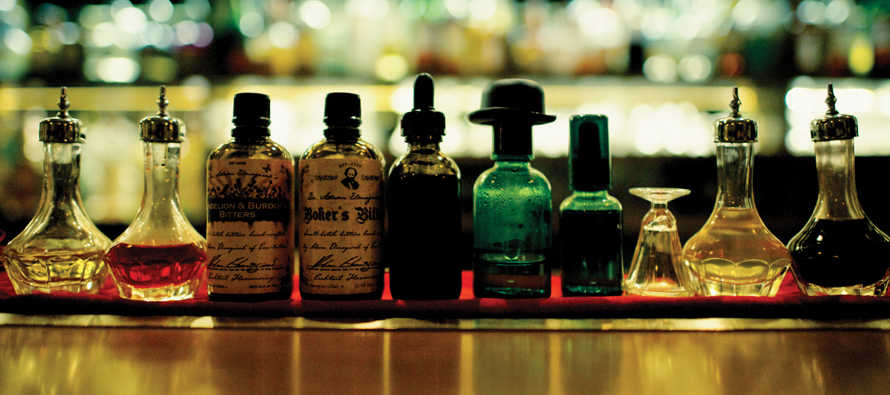The Bitter Truth

Found in every high-end cocktail lounge and neighborhood haunt, bitters are enjoying a serious revival within the service industry. Available in nearly every flavor profile imaginable, bitters conjure up a close association with the cocktail hour with connotations of luxury, leisure and time to kill. With that image in mind, understanding the concept of bitters as originally intended proves difficult. We are inclined to view bitters as a consumable item, intended to open the palate and complement the beverage, lacking the knowledge of bitters in their original purpose – as medicine.
What we recognize today as bitters differs significantly from the herbal bitters of yore. These concoctions treated a wide array of ailments, from respiratory complaints to mental fatigue, but their main purpose was to aid in digestion.
The exact composition of the bitters varied dramatically from region to region, with respect to availability of plant material – the species of gentian used in tonic bitters, great yellow gentian (Gentiana lutea) grows native to south and central Europe, while species of wild cherry (Prunus spp.) can be found in the Americas, Asia and Europe. In the same breath, the now-ubiquitous hops (Humulus lupulus) remained uncultivated in North America until the early seventeenth century. One might imagine the earliest American settlers, wishing to recreate their native herbal remedies, but faced with a daunting landscape of unfamiliar flora. Of course, the pioneer spirit prevailed.
Regardless of biome or climate, the basic method for making bitters remained the same: a base alcohol extracted the medicinal and flavoring properties of various plant materials. Many of the medicinal plants employed in traditional Western herbalism possessed an intense bitterness. To lessen the unpleasantness of consuming such a bitter brew, more agreeable ingredients like citrus rind and sweetly-scented flowers found their way into the mix.
Though their homeopathic use has been rendered largely obsolete by the prevalence of Western allopathic medicine, many herbs can still be readily employed in home infusions and bitters. A list of notable bitters herbs follows.
Gentian, specifically Great Yellow Gentian (Gentiana lutea)
Native range: Alpine and sub-alpine areas of central and southern Europe.
Historical herbal uses: Emmenagogue, antiseptic, digestive aid.
Plant part used: Root
The granddaddy of all bittering agents, possessed of an almost monumental bitterness, gentian root remains a primary ingredient in standby brands like Angostura and Peychaud’s. The plant contains some of the bitterest compounds known to natural science. Considered a fortifying herb for the digestive system, gentian also found use as a natural combatant of the exhaustion and lack of appetite associated with chronic disease.
With a place in the European herbalist’s kit for thousands of years, gentian made its way into all kinds of classic European aperitif, digestif and amaro-styled liqueurs – Suze, Aperol and Fernet among them. Due to its extreme bitterness, gentian root is best used sparingly in home bitters preparations. A little goes a long way.
Dandelion (Taraxacum officinale)
Native range: Europe and Asia; naturalized throughout North America, southern Africa, South America, New Zealand, Australia and India.
Historical herbal uses: Diuretic, laxative, appetite stimulant, digestive aid.
Plant part used: Root
Yes, this is the common weed your dad spent hours trying to eradicate from the cracks in the driveway. In America it appears in any vacant bit of ground it can find, its sunny head bobbing in the breeze. In Europe, the plants are larger, with strong stems, finely serrated leaves and a better reputation. The entire plant is renowned in all types of herbal medicine as a tonic herb, reputed to purify the blood. Dandelion root and leaves are exceptionally high in vitamins and nutrients. In herbal tradition, the root of the plant is considered a diuretic. The roots, when dried and chopped, impart a considerably mild bitterness, with earthy and vegetal notes, highlighted nicely in tandem with meadow flowers and honey.
Wild Cherry (Prunus serotina or Prunus virginiana)
Native range: Eastern North America, ranging north to south from Canada to Texas and Florida.
Historical herbal uses: Cold suppressant, respiratory aid, digestive aid.
Plant part used: Outer bark
The storied cherry tree plays a central symbolic role in many folktales from around the world. Most tales revolve around the cherry as a symbol of female chasteness and virginity, but we’re all familiar with the story of George Washington and the cherry tree as a parable of American honesty and integrity. Unlike its domesticated counterpart, the wild cherry tree produces unremarkable fruit; rather, its bounty lies in its bark. Wild cherry is valued for timber and imparts a distinct fruit wood flavor to meats smoked with its wood. Traditionally, effective cough syrup could be made from its bark – hence the well-known ‘wild cherry’ flavor found in modern cough remedies, as well as most slushies and sodas at a gas station near you. As a bittering agent, wild cherry bark proves a smooth addition to whiskey-based recipes, pairing well with citrus and unsurprisingly, drupe fruits like cherries and peaches.
Wormwood (Artemesia absinthium).
Native range: Native to temperate regions of Europe, Asia and Northern Africa.
Traditional herbal uses: Emmenagogue, cardiac stimulant, digestive aid.
Plant part used: Leaves, aerial parts.
‘As bitter as wormwood’ the old saying goes, and there is no question that wormwood is bitter, indeed. The plant achieved contemporary notoriety as a primary ingredient of absinthe, favored drink of artists like Hemingway and Van Gogh. As such, it remains a controversial and oft-maligned herb. Wormwood contains thujone, a psychoactive chemical compound that may induce hallucinations and can be fatally toxic if consumed in large doses. However, much of the bad press about this ancient plant can be attributed to misinformation, bad research and widespread moral panic at the close of the nineteenth century.
Long employed as an additive to spirits, wines and beer, wormwood was also thought to stimulate the appetite and relieve indigestion. When used in bitters, wormwood imparts green chlorophyll bitterness, similar to fresh yarrow and carrot tops, which works well in a neutral or gin-based recipe. A note of caution: wormwood remains regulated by the FDA and similar organizations for its potential toxicity. I do not recommend the use of wormwood in bitters. Proceed at your own risk.
Herbs with a longstanding medicinal tradition possess rather strong magic, and as such should be treated with respect. When choosing materials for homemade bitters, be sure to use a reputable and ethical source. Some of the best plants for bitters are also the most ecologically fragile. Companies like Mountain Rose Herbs (www.mountainroseherbs.com) and Dandelion Botanical Company (www.dandelionbotanical.com) offer high quality, organic products and practice respectful harvest and cultivation of their plant materials. Due to the potency of many bitter herbs, practice moderation when employing bittering agents in home preparations. Too much of a good thing can be a real stomachache.
If you feel ambitious but don’t know where to begin, try this recipe at home.
Spiced Bitters
2 cups high-proof bourbon or rye whiskey
1 cup pecans, toasted
1 whole nutmeg, cracked
2 cinnamon sticks
3 tbsp dried orange peel
5 star anise pods
2 vanilla beans, split
1 tsp allspice berries
1 tsp clove buds
1 tsp wild cherry bark
1 tsp white pine bark
½ tsp gentian root
½ tsp black peppercorns, cracked
3 tbsp pure maple syrup
Combine all ingredients except syrup in a glass jar. Cap and shake well, then store jar in a dark place for three to four weeks. Shake jar daily.
After three weeks, taste the infusion. At this point, if a certain flavor tastes too overpowering, you can remove that particular ingredient and allow the infusion to further develop. When the flavor suits you, strain the infused liquid into a clean jar using cheesecloth and a bar-sized metal strainer if necessary. Repeat straining process to remove any sediment.
Pour infused alcohol into a clean saucepan and add syrup. Bring mixture to a boil, and then simmer for a few moments to reduce the liquid. Allow mixture to cool then return to glass jar. Return jar to its dark place for a few days. Divide the bitters into dark glass bottles with dasher caps or dropper lids; slap a nametag on the bottles.
Store the bitters at room temperature. They will last indefinitely, but the flavor will be best if used within twelve months.
Please note: this information has not been evaluated by the Food and Drug Administration (FDA). The author is not a licensed herbalist or medical professional. This information is for lively educational purposes only and is not intended to diagnose, treat, cure, or prevent any disease.

Mallory Finch
Mallory Finch is an entrepreneur with an ardent interest in the intersection of food and spirits. Born and raised in the Midwest, Mallory constantly seeks to broaden her knowledge of native edibles and herbs through self-education and discovery. In 2013, she co-founded Black Iris Botanicals, an herbal body care and cosmetics venture which focuses on local and natural sources.
Related Articles
Sodas in Which You May Not Be Entirely Aware of: Triple Cola
This one really pisses me off. We are looking at Triple Cola this week. Oh, on the surface, it seems
Globally First: Whiskey Dispensing Makes Mark in Omaha
Imagine creating an appeal to a global company whose business plan is, metaphorically, carved in stone. Picture the change is
The Industry Choice: Provide Service or Be Servile
The professional bartender of the Pre-Prohibition era was a respected and skilled tradesman, working only with preferred spirits, hand-cut (or
No comments
Write a commentOnly registered users can comment.














